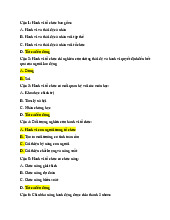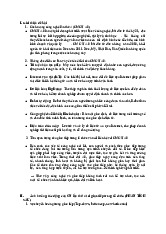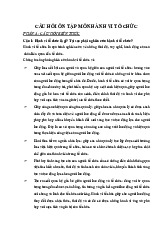



















Preview text:
lOMoAR cPSD| 61229936
Chapter 1 What Is Organizational Behavior? MULTIPLE CHOICE
Importance of Interpersonal Skills 1.
Over the past two decades, business schools have added required courses on people skills to many
of their curricula. Why have they done this? a.
Managers no longer need technical skills in subjects such as economics and accounting to succeed. b.
There is an increased emphasis in controlling employee behavior in the workplace. c.
Managers need to understand human behavior if they are to be effective. d.
These skills enable managers to effectively lead human resources departments. e.
A manager with good people skills can help create a pleasant workplace.
(c; Moderate; Interpersonal Skills; p. 4) {AACSB: Analytic Skills} 2.
Which of the following is most likely to be a belief held by a successful manager? a.
Technical knowledge is all that is needed for success. b.
It is not essential to have sound interpersonal skills. c.
Technical skills are necessary, but insufficient alone for success. d.
Effectiveness is not impacted by human behavior. e.
Technical skills do not influence efficiency.
(c; Easy; Interpersonal Skills; p. 5) {AACSB: Analytic Skills} lOMoAR cPSD| 61229936 e. What Managers Do 3.
Which of the following would not be considered an organization? a. a church b. a university c. a military unit d.
all adults in a given community e. an elementary school
(d; Moderate; Organization; p. 6) {AACSB: Analytic Skills} 4.
Which of the following is best defined as a consciously coordinated social unit, composed of two
or more people, which functions on a relatively continuous basis to achieve a common goal or set of goals? a. party b. unit c. team d. community e. organization (e; Easy; Organization; p. 6) 5.
Which of the following is least likely to be considered a manager? a.
an administrator in charge of fund-raising activities in a non-profit organization b.
a lieutenant leading an infantry platoon c.
a doctor who acts as head of the physiotherapy department at a public hospital lOMoAR cPSD| 61229936 the mayor of a large city
an IT technician who enables communication between all of a company’s employees
(e; Challenging; Managers; p. 6) {AACSB: Analytic Skills} 6.
Which of the following is not one of the four primary management functions? a. controlling b. planning c. staffing d. organizing e. leading
(c; Moderate; Management Functions; p. 6) {AACSB: Analytic Skills} 7.
Which of a manager’s primary roles requires the manager to define an organization’s goals,
establish an overall strategy for achieving these goals and develop a comprehensive hierarchy of
plans to integrate and coordinate activities? a. controlling b. planning c. staffing d. coordinating e. leading
(b; Moderate; Management Functions; p. 6) {AACSB: Analytic Skills} 8.
Determining how tasks are to be grouped is part of which management function? a. planning b. leading c. controlling lOMoAR cPSD| 61229936 e. organizing lOMoAR cPSD| 61229936 e. contemplating
(d; Easy; Management Functions; p. 6) {AACSB: Analytic Skills} 9.
Mintzberg concluded that managers perform 10 different, highly interrelated roles. Which of
the following is one of the broad categories into which these roles could be grouped? a. intrapersonal b. institutional c. decisional d. affective e. reflective
(c; Moderate; Management Roles; p. 7) {AACSB: Analytic Skills} 10.
As a manager, one of Joe’s duties is to present awards to outstanding employees within his
department. Which Mintzberg managerial role is Joe acting in when he does this? a. leadership role b. liaison role c. monitor role d. figurehead role e. spokesperson role
(d; Challenging; Interpersonal Roles; p. 7) {AACSB: Analytic Skills} 11.
According to Mintzberg, one of management’s interpersonal roles is _____. a. spokesperson b. leader c. negotiator monitor lOMoAR cPSD| 61229936 e. devil’s advocate
(b; Moderate; Interpersonal Roles; p. 7) {AACSB: Analytic Skills} 12.
According to Mintzberg, when a manager searches the organization and its environment for
opportunities and initiates projects to bring about change, the manager is acting in which role? a. negotiator b. entrepreneur c. monitor d. resource allocator e. reflective analyst
(b; Challenging; Decisional Roles; p. 7) {AACSB: Analytic Skills} 13.
Robert Katz identified three essential skills that managers need to have in order to reach their goals. What are these skills? a.
technical, decisional and interpersonal b.
technical, human, and conceptual c.
interpersonal, informational and decisional d.
conceptual, communication and networking e.
human, informational and communication
(b; Moderate; Management Skills; p. 8) {AACSB: Analytic Skills} 14.
A manager is valued by her colleagues for her ability to perform effective break-even analysis on
upcoming ventures. In this case, her colleagues value her for competencies that fall within which
of Katz’s essential management skills categories? technical communication human conceptual education
(a; Moderate; Technical Skills; p. 8) {AACSB: Analytic Skills} lOMoAR cPSD| 61229936 15.
According to Katz, technical skills encompass the ability to _____. a.
analyze and diagnose complex situations b.
exchange information and control complex situations c.
apply specialized knowledge or expertise d.
initiate and oversee complex projects e.
communicate effectively with others
(c; Challenging; Technical Skills; p. 8) 16.
Which one of the following would not be considered a human skill in Katz’s structure? a. decision making. b. communicating c. resolving conflicts d. working as part of a team e. listening to others
(a; Easy; Human Skills; p. 8) {AACSB: Analytic Skills} 17.
According to Katz, when managers have the mental ability to analyze and diagnose complex
situations, they possess _____ skills. technical leadership problem-solving conceptual lOMoAR cPSD| 61229936 reactive
(d; Moderate; Conceptual Skills; p. 8) {AACSB: Analytic Skills} 18.
According to Fred Luthans and his associates, which of the following is considered a part of traditional management? a. disciplining b. decision making c.
exchanging routine information d. acquiring resources e. investing
(b; Moderate; Traditional Management; p. 8) {AACSB: Analytic Skills} 19.
Which of Luthans’ managerial activities involves socializing, politicking, and interacting with
outsiders? traditional management communicating human resource management networking investing (d; Easy; Networking; p. 9) 20.
How does Luthans define a manager’s success? a.
by the quantity and quality of their performance b.
by the satisfaction and commitment of their employees c.
by the rate and quantity of pay raises d.
by the speed of their promotion e.
by their scores on a 360-degree feedback analysis
(d; Moderate; Successful Managerial Activities; p. 9) 21.
According to Luthans’ research, successful managers spent more of their time on _____ than on any other activity. lOMoAR cPSD| 61229936 traditional management human
resource management networking communicating hiring and firing
(c; Moderate; Networking; p. 9) 22.
What did a study of U.S. managers indicate about those managers who seek information from colleagues and employees? a. They are rapidly promoted. b.
They are generally more popular. c.
They are less efficient as leaders. d.
They are generally given fewer promotions, raises and other rewards. e.
They are generally more effective managers.
(e; Moderate; Effective Managerial Activities; p. 9) {AACSB: Communication} EMBED PBrush 23.
The pie charts above show how 5 different managers spent their time. According to Luthans’
research, which manager is most likely to receive more promotions and other rewards associated with career success? a. Manager A b. Manager B c. Manager C d. Manager D e. Manager E
(c; Moderate; Successful Managerial Activities; p. 9) {AACSB: Analytic Skills} lOMoAR cPSD| 61229936 24.
While the Functions, Roles, Skills, and Activities approaches to management all differ, they all
recognize that effective and successful managers must develop which of the following? a. people skills b. technical skills c. efficiency d. entrepreneurialism e. ability to network
(a; Moderate; Manager’s Job; p. 10) Enter Organizational Behavior 25.
An OB study would be least likely to be used to focus on which of the following problems? a.
an increase in absenteeism at a certain company b.
a fall in productivity in one shift of a manufacturing plant c.
a decrease in sales due to growing foreign competition d.
an increase in theft by employees at a retail store e.
excessive turnover in volunteer workers at a non-profit organization
(c; Moderate; Organizational Behavior; p. 10) {AACSB: Analytic Skills} 26.
What are the three primary determinants of behavior that organizational behavior focuses upon? a.
profit structure, organizational complexity, job satisfaction b.
individuals, profit structure, and job satisfaction c.
individuals, groups, and job satisfaction d.
groups, structure, and profit structure e.
individuals, groups, and structure
(e; Challenging; Organizational Behavior; p. 10) {AACSB: Analytic Skills} lOMoAR cPSD| 61229936 lOMoAR cPSD| 61229936 27.
______ is a field of study that investigates the impact that individuals, groups, and structure have
on behavior within organizations for the purpose of applying such knowledge toward improving
an organization’s effectiveness. Organizational development Human Resources Management Organizational behavior People management Corporate strategy
(c; Easy; Organizational Behavior; p. 10) 28.
Which of the following is not a core topic of organizational behavior? motivation attitude
development conflict resource allocation work design
(d; Moderate; Organizational Behavior; p. 11) {AACSB: Analytic Skills}
Complementing Intuition with Systematic Study 29.
In order to predict human behavior, it is best to supplement your intuitive opinions with
information derived in what fashion? a. common sense b. direct observation c. systematic inquiry d. speculation e. organizational theory
(c; Moderate; Systematic Study; p. 11) 30.
Which of the following is a reason that the study of organizational behavior is useful? a.
Human behavior does not vary a great deal between individuals and situations. lOMoAR cPSD| 61229936 b. Human behavior is not random. c.
Human behavior is not consistent. d.
Human behavior is rarely predictable. e.
Human behavior is often not sensible.
(b; Easy; Systematic Study; p. 11) {AACSB: Analytic Skills} 31.
What approach involves managers centering their decisions on the best available scientific data? a. intuition b.
organizational behavioral studies c. substantive evidence approach d. preconceived notions e. evidence based management
(e; Easy; Evidence Based Management; p. 11) 32.
What do the fundamental consistencies underlying the behavior of all individuals enable researchers to do? a. observe human behavior b. systematize human behavior c. research human behavior d. predict human behavior e. detect human behavior
(d; Moderate; Systematic Study; p. 11) 33.
Analyzing relationships, determining causes and effects, and basing conclusions on scientific
evidence all constitute aspects of _____ study. a. organizational b. intuitive c. theoretical lOMoAR cPSD| 61229936 d. systematic e. case-based
(d; Moderate; Systematic Study; p. 11) 34.
What do the authors of the textbook advise? a.
disregard your intuition because it’s usually wrong and will lead to incorrect assumptions b.
use evidence as much as possible to inform your intuition and experience c.
rely on research since it is almost always right and researchers don’t make mistakes d.
make predictions of individuals’ behaviors based on others’ actions e.
don’t trust preconceived notions unless you have substantive evidence to back them up
(b; Moderate; Systematic Study; p. 13)
Disciplines That Contribute to the OB Field 35.
Organizational behavior is constructed from all of the following disciplines except _____. a. physics b. psychology c. anthropology d. sociology e. social psychology
(a; Easy; Behavioral Sciences; p. 13) {AACSB: Analytic Skills} 36.
Psychology’s major contributions to the field of organizational behavior have been primarily at what level of analysis? lOMoAR cPSD| 61229936 a. the level of the group b. the level of the individual c. the level of the organization d. the level of the culture e.
the level of interacting groups
(b; Moderate; Psychology; p. 13) 37.
Which behavioral science discipline is most focused on understanding individual behavior? a. sociology b. social psychology c. psychology d. anthropology e. organizational behavior (c; Easy; Psychology; p. 13) 38.
The science that seeks to measure, explain, and sometimes change the behavior of humans and
other animals is known as _____. a. psychiatry b. psychology c. sociology d. political science e. organizational behavior
(b; Moderate; Psychology; p. 13) {AACSB: Analytic Skills} 39.
_____ blends concepts from psychology and sociology. a. Corporate strategy b. Anthropology lOMoAR cPSD| 61229936 c. Political science. d. Social psychology e. Archaeology
(d; Easy; Social Psychology; p. 14) {AACSB: Analytic Skills} 40.
The science that focuses on the influence people have on one another is _____. a. psychology b. anthropology c. political science d. social psychology e. archaeology
(d; Moderate; Social Psychology; p. 14) {AACSB: Analytic Skills} 41.
Group behavior, power, and conflict are central areas of study for _____. a. archaeologists b. sociologists c. anthropologists d. social psychologists e. operations analysts
(d; Moderate; Social Psychology; p. 14) {AACSB: Analytic Skills} 42.
_____ focuses on the study of people in relation to their social environment. Psychology Sociology Corporate strategy Political science lOMoAR cPSD| 61229936 Operations management
(b; Moderate; Sociology; p. 15) {AACSB: Analytic Skills} 43.
Significant contributions to OB in the study of group behavior in organizations have been made by _____. a. psychologists b. sociologists c. anthropologists d. political scientists e. operations analysts
(b; Moderate; Sociology; p. 15) {AACSB: Analytic Skills} 44.
Which field of study has contributed to OB through its research on organizational culture and
formal organization theory and structure? a. psychology b. operations management c. corporate strategy d. political science e. sociology
(e; Moderate; Sociology; p. 15) {AACSB: Analytic Skills} 45.
Which of the following fields has most helped us understand differences in fundamental values,
attitudes, and behavior among people in different countries? a. anthropology b. psychology c. political science d. operations research e. psycholinguistics
(a; Challenging; Anthropology; p. 15) {AACSB: Analytic Skills} lOMoAR cPSD| 61229936 46.
The subject of organizational culture has been most influenced by which behavioral science discipline? a. anthropology b. psychology c. social psychology d. political science e. corporate strategy
(a; Moderate; Anthropology; p. 15) {AACSB: Analytic Skills} There are Few Absolutes in OB 47.
Which of the following statements best describes the current status of Observational Behavior concepts? a.
They are based on universal truths. b.
They can be used to predict human behavior only if the situation is clearly specified. c.
There is general consensus among OB researchers and scholars on the
simple concepts that underlie most human behavior. d.
The cause-effect principles that tend to apply to all situations have been discovered. e.
Cause and effect relationships for most human behaviors have been isolated.
(b; Easy; Observational Behavior; p. 16) {AACSB: Analytic Skills} 48.
There are _____ simple and universal principles that explain organizational behavior. a. an infinity of b. absolutely no c. a confusing array of d. fourteen lOMoAR cPSD| 61229936 e. few if any
(e; Challenging; Observational Behavior; p. 16) 49.
In order to predict human behavior with any degree of accuracy, what sort of variables must be taken into account? a. global b. general c. dependent d. non-reactive e. contingency
(e; Moderate; Contingency Variables; p. 16)
Challenges and Opportunities for OB 50.
_____ is/are the number one reason that business travelers have cut back on their travel. a. Lower profits b. Shareholder interventions c.
Greater communications technology d. Better accounting principles e. Fear of terrorism
(e; Moderate; Responding to Globalization; p. 18) 51.
Which of the following OB topics is not central to managing employees’ fears about terrorism? a. emotion b. motivation c. communication d. leadership lOMoAR cPSD| 61229936 e. work design
(e; Easy; Responding to Globalization; p. 18) 5.
Whereas _____ focuses on differences among people from different countries, _____ addresses
differences among people within given countries. a.
workforce diversity; globalization b.
globalization; workforce diversity c. culture; diversity d.
culturization; workforce diversity e. psychology; social psychology
(b; Challenging; Globalization and Workforce Diversity; p. 18) {AACSB: Analytic Skills} {AACSB: Multicultural and Diversity} 53.
_____ is a measure of how organizations are becoming more heterogeneous in terms of gender, race, and ethnicity. Globalization Workforce diversity Affirmative action Organizational culture Operational homogeneity
(b; Easy; Workforce Diversity; p. 18) {AACSB: Multicultural and Diversity} 54.
In what way does current thought on workplace diversity differ from the older “melting-pot” assumption?
by recognizing that employees don’t set aside their cultural values, lifestyle preferences, and differences when they come to work
by realizing that people from diverse backgrounds will automatically begin to integrate into the larger
workplace and community over time




